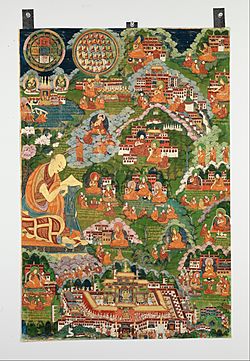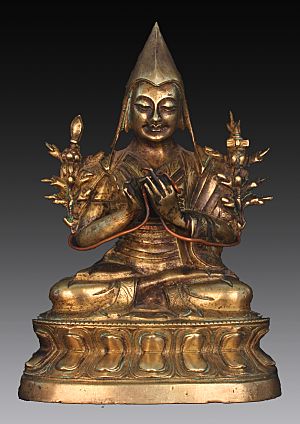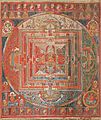Je Tsongkhapa facts for kids
Quick facts for kids
Tsongkhapa, Wylie:tsong kha pa
Tibetan:ཙོང་ཁ་པ། Traditional Chinese:宗喀巴, Simplified:宗喀巴, Pinyin:Zōngkàbā |
|
|---|---|

Thangka of Tsongkhapa - Sichuan University Museum - Chengdu, China
|
|
| Born | c. 1357 CE Amdo
|
| Died | c. 1419 CE (aged 61–62) |
| Occupation | Buddhist teacher, monk and philosopher |
| Known for | Founder of the Gelug school |
Tsongkhapa ("The man from Tsongkha", 1357–1419), usually taken to mean "the Man from Onion Valley", born in Amdo, was a famous teacher of Tibetan Buddhism whose activities led to the formation of the Gelug school of Tibetan Buddhism. He is also known by his ordained name Losang Drakpa (Wylie: blo bzang grags pa) or simply as "Je Rinpoche" (Wylie: rje rin po che). Also, he is known by Chinese as Zongkapa Lobsang Zhaba, He was the son of a Tibetan Longben Tribal leader who also once served as an official of the Yuan Dynasty of China.
In his two main treatises, the Lamrim Chenmo (Wylie: lam rim chen mo) and Ngakrim Chenmo (Wylie: sngags rim chen mo), Tsongkhapa meticulously sets forth this graduated way and how one establishes oneself in the paths of sutra and tantra.
Biography
Early years
With a Mongolian father and a Tibetan mother, Tsongkhapa was born into a nomadic family in the walled city of Tsongkha in Amdo, Tibet (present-day Haidong and Xining, Qinghai) in 1357. It is said that the Buddha Sakyamuni spoke of his coming as an emanation of the Bodhisattva Manjusri in the short verse from the Root Tantra of Manjushri (Wylie: 'jam dpal rtsa rgyud):
After I pass away
And my pure doctrine is absent,
You will appear as an ordinary being,
Performing the deeds of a Buddha
And establishing the Joyful Land, the great Protector,
In the Land of the Snows.
According to hagiographic accounts, Tsongkhapa's birth was prophesied by the 12th abbot of the Snar thang monastery, and was recognized as such at a young age, taking the lay vows at the age of three before Rolpe Dorje, 4th Karmapa Lama and was named Künga Nyingpo (Wylie: kun dga' snying po). At the age of seven, he was ordained as a śrāmaṇera by Döndrup Rinchen (Wylie: don grub rin chen, 1309–1385), the first abbott of Jakhyung Monastery (Wylie: bya khyung brag), and was given the ordination name Losang Drakpa (Wylie: blo bzang grags pa).
Monastic career
It was at this early age that he was able to receive the empowerments of Heruka, Hevajra, and Yamantaka, three of the most prominent wrathful deities of Tibetan Buddhism, as well as being able to recite a great many Sutras, not the least of which was Mañjuśrīnāmasamgīti. He would go on to be a great student of the vinaya, the doctrine of behaviour, and even later of the Six Yogas of Naropa, the Kalachakra tantra, and the practice of Mahamudra. At the age of 24, he received full ordination as a monk of the Sakya school.
From Zhönnu Lodrö (Wylie: gzhon nu blo gros) and Rendawa (Wylie: red mda' pa), he received the lineage of the Pramanavarttika transmitted by Sakya Pandita. He mastered all the courses of study at Drigung kagyud Monastery in Ü-Tsang.
As an emanation of Manjusri, Tsongkhapa is said have been of "one mind" with Atiśa, received the Kadam lineages and studied the major Sarma tantras under Sakya and Kagyu masters. He also studied with a Nyingma teacher, the siddha Lek gyi Dorjé (Wylie: legs gyi rdo rje) and the abbot of Shalu Monastery, Chö kyi Pel (Wylie: zhwa lus pa chos kyi dpal), and his main Dzogchen master was Drupchen Lekyi Dorje (Wylie: grub chen las kyi rdo je), also known as Namkha Gyaltsen (Wylie: nam mkha' rgyal mtshan, 1326–1401).
In addition to his studies, he engaged in extensive meditation retreats. He is reputed to have performed millions of prostrations, mandala offerings and other forms of purification practice. Tsongkhapa often had visions of iṣṭadevatās, especially of Manjusri, with whom he would communicate directly to clarify difficult points of the scriptures.
Honours
Tsongkhapa was one of the foremost authorities of Tibetan Buddhism at the time. He composed a devotional prayer called the Migtsema Prayer to his Sakya master Rendawa, which was offered back to Tsongkhapa, with the note of his master saying that these verses were more applicable to Tsongkhapa than to himself.
Death
Tsongkhapa died in 1419 at the age of sixty-two. After his death several biographies were written by Lamas of different traditions. Wangchuk Dorje, 9th Karmapa Lama, praised Tsongkhapa as one "who swept away wrong views with the correct and perfect ones." Mikyö Dorje, 8th Karmapa Lama, wrote in his poem In Praise of the Incomparable Tsong Khapa:
When the teachings of the Sakya, Kagyue, Kadam
And Nyingma sects in Tibet were declining,
You, O Tsong Khapa, revived Buddha's Doctrine,
Hence I sing this praise to you of Ganden Mountain.
Philosophy and practice
Background
Tsongkhapa was acquainted with all Tibetan Buddhist traditions of his time, and received lineages transmitted in the major schools. His main source of inspiration was the Kadam school, the legacy of Atiśa. Tsongkhapa received two of the three main Kadampa lineages (the Lam-Rim lineage, and the oral guideline lineage) from the Nyingma Lama, Lhodrag Namka-gyeltsen; and the third main Kadampa lineage (the lineage of textual transmission) from the Kagyu teacher Lama Umapa.
Tsongkhapa's teachings drew upon these Kadampa teachings of Atiśa, emphasizing the study of Vinaya, the Tripiṭaka, and the Shastras. Atiśa's Lamrim inspired Tsongkhapa's Lamrim Chenmo, which became a main text among his followers. He also practised and taught extensively the Vajrayana, and especially how to bring the Sutra and Tantra teachings together, wrote works that summarized the root teachings of the Buddhist philosophical schools, as well as commentaries on the Prātimokṣa, Prajnaparamita, Candrakirti's Madhyamakavatara, logic, Pure Land and the Sarma tantras.
Essentials
According to Thupten Jinpa, the following elements are essential in a coherent understanding of Tsongkhapa's understanding and interpretation of the Madhyamaka refutation of essentialist ontology:
- Tsongkhapa's distinction between the domains of the conventional and ultimate perspectives;
- Tsongkhapa's insistence on a prior, correct conceptual identification of the object of negation;
- Tsongkhapa's differentiation of the various connotations of the all-important term 'ultimate' (paramartha skt.);
- Tsongkhapa's distinction he draws between that which is not found and that which is negated.
Philosophy
For Tsongkhapa, calming meditation alone is not sufficient, but should be paired to rigorous, exact thinking "to push the mind and precipitate a breakthrough in cognitive fluency and insight."
Prasangika - rejection of essentialism
Tsongkhapa was a proponent of Candrakirti's consequentialist or prasangika interpretation of the Madhyamaka teachings on sunyata (emptiness), rejecting the Svatantrika point of view. According to Tsongkhapa, the Prāsaṅgika-approach is the only acceptable approach within Madhyamaka, rejecting the Svatantrikas because they state that the conventional reality is "established by virtue of particular characteristics" (rang gi mtshan nyid kyis grub pa):
The opponents of Candrakirti's Prasanna-padā are both (a) the essentialists, who accept that things ultimately have intrinsic nature, and (b) the Svātantrikas, who refute that, but accept that things conventionally have intrinsic character or intrinsic nature.
The classification into Prasangika and Svatantrika originated from their different usages of reason to make "emptiness" understandable. The Svātantrikas strive to make positive assertions to attack wrong views, whereas the Prasangikas draw out the contradictory consequences (prasanga) of the opposing views. In Tsongkhapa's reading, the difference becomes one of the understanding of emptiness, which centers on the nature of conventional existence. The Svātantrikas state that conventional phenomena have particular characteristics, by which they can be distinguished, but without an ultimately existing essence. In Tsongkhapa's understanding, these particular characteristics are posited as establishing that conventionally things do have an intrinsic nature, a position which he rejects:
Svatantrikas (like Bhavaviveka) are those Madhyamikas who accept that, at a conventional level, things actually do have intrinsic nature just as they are perceived. To exist at all entails having intrinsic existence. However, since there is nothing that holds up under ultimate analysis, everything is ultimately empty. Emptiness is the lack of ultimate existence.
Although Tsongkhapa is regarded as the great champion of the Prasangika-view, according to Thomas Doctor, Tsongkhapa's views on the difference between Prasanghika and Svatantrika are preceded by a 12th-century author, Mabja Jangchub Tsondru (d. 1185).
Tsongkhapa nevertheless argues that the Prāsaṅgika's use of reductio ad absurdum is also syllogistic, because one "refutes the opponent using a subject, a reason, and so forth that are accepted by that opponent."
Conventional valid cognition
While objecting to Bhavaviveka's understanding of a shared object at the conventional level, Tsongkhapa has to leave intact conventional reality and causality, to keep intact the teachings on cyclic existence and the basis for moral behavior. Therefore, he has to explain how conventional reality is perceived in a valid way, which he does by introducing "conventional valid cognition."
According to Tsongkhapa, following Candrakirti, all phenomena are empty of inherent existence or essence, because they are dependently co-arisen with (created by) mental imputation. All phenomena in all possible worlds lack inherent existence and come into existence relative to a designating consciousness which co-arises with that phenomenon.
From the Prāsaṅgika perspective, in order for something to exist, it must be designated validly by a designating consciousness. To talk about an object that does not exist in relation to a subject is incoherent. Anything which comes into existence through valid designation is part of "conventional reality" or "conventional truth." According to Lama Tsongkhapa, something is validly designated (exists conventionally) if it meets all of the following three conditions:
- It is known to a conventional consciousness;
- No other conventional cognition (within that convention) contradicts it from being thus known;
- Reason that accurately analyzes reality — that is, analyzes whether something intrinsically exists — does not contradict it.
Whatever fails to meet those criteria does not exist, and relationships between objects cannot exist without being validly designated into existence.
Nevertheless, Prāsaṅgika are not stating that nothing exists, but instead, hold that phenomena only come into existence co-dependently with minds which are applying conceptual and nominal conventions to uncharacterized mere experiences. Things and phenomena do exist co-dependently, based upon a relationship with a knowing and designating mind, but nothing exists - including the fundamental characteristics which compose our experience - in an independent, self-arising, or self-sustaining manner.
Identifying the correct Object of Negation
For Tsongkhapa, extended rational analysis is required to correctly establish what it is that is to be negated. This correct establishment is necessary to reach a liberating insight into emptiness, while avoiding the trap of nihilism, the possibility that "seeming reality becomes extinct or invalidated if a phenomenon is empty of that very phenomenon."
While the "I" or self is accepted as nominally existing in a conventional way, for Tsongkhapa, following Candrakirti, the object to be negated by reason is the "metaphysical fiction" of an intrinsic nature which is "erroneously reified." Tsongkhapa argues that "there exists within each of us a natural belief, [a naive, normal, pre-philosophical way of seeing the world], which leads us to perceive things and events as possessing some kind of intrinsic existence and identity." It is this mistaken perception which is the object to be negated.
According to Tsongkhapa, Buddhist (in concreto, the Sarvastivada) and non-Buddhist essentialist schools are not negating the correct object, but are only negating "imaginary constructs" and "acquired ignorance," not the innate perception of an inherently existing self. They have "realized only a coarse selflessness and having thereby suppressed, but not removed from the root, the obstructions to liberation." According to Tsongkhapa, the negation of acquired, philosophical notions won't eradicate the afflictions or free one from cycles of rebirth. The negation has to go further, since the object of negation is not an acquired, philosophical notion of a permanent self, but the innate perception of an inherently existing self.
Gyumed Khensur Rinpoche Lobsang Jampa, referring to Kalden Gyatso, notes that "there are actually two objects that must be refuted or destroyed," namely this sense of "I," and the subjective self, "the mind grasping at that false 'I'." By analyzing the sense of "I" and its logical contradictions, its seemingly true existence is seen through, which "destroys the continuum of the subjective mind grasping it. What continues is a wisdom mind."
Lack of Intrinsic Nature
According to Patrick Jennings,
Tsongkhapa describes a procedure for establishing the non-existence of a substantial, abiding essence in either the self or in 'exterior' phenomena, such as pots or potatoes. It is essential during this procedure that one does not confuse the non-findability of a substantial, non-relational self with the refutation of the existence of a relative or conventional self – the self as it appears to ordinary cognition and which is subject to the law of cause and effect.
This procedure is described in chapter 23, The person Lacks Intrinsic Nature, of volume three of the Lamrim Chenmo, and entails four steps:
- The refutation of the position that the self is one with the aggregates
- The refutation of the position that the self is different from the aggregates
- How those arguments also refute each of the remaining positions
- How the person appears like an illusion based on that refutation
Emptiness
Tsongkhapa saw emptiness as a consequence of pratītyasamutpāda (dependent arising), the teaching that no dharma ("thing") has an existence of its own, but always comes into existence in dependence on other dharmas. According to Tsonghkhapa, dependent-arising and emptiness are inseparable.
Tsongkhapa's view on "ultimate reality" is condensed in the short text In Praise of Dependent Arising, also known as In Praise of Relativity and The Essence of Eloquency. It states that "things" do exist conventionally, but ultimately everything is dependently arisen, and therefore void of inherent existence:
Whatever depends on causes and conditions
Is empty of intrinsic reality
What excellent instruction could there be
More marvellous than this discovery?
This means that conventionally things do exist, and that there is no use in denying that. But it also means that ultimately those things have no 'existence of their own', and that cognizing them as such results from cognitive operations, not from some unchangeable essence. Tsongkhapa:
Since objects do not exist through their own nature, they are established as existing through the force of convention.
According to Tsongkhapa, emptiness is empty of inherent existence: emptiness only exists nominally and conventionally. Emptiness is co-dependently arisen as a quality of conventional phenomena and is itself a conventional phenomenon. There is no "transcendental ground," and "ultimate reality" has no existence of its own, but is the negation of such a transcendental reality, and the impossibility of any statement on such an ultimately existing transcendental reality: it is no more than a fabrication of the mind. Emptiness is an ultimate truth (a fact which applies to all possible phenomena, in all possible worlds), but it is not an ultimate phenomenon or ultimate reality (something which has always existed, is self-created, and is self-sustaining). It is also not a "Tao" or a primal substance from which all other things arise. Buddhapalita:
There is no way to overcome the misconceptions of those who think that emptiness is a real thing. For example, if you tell someone, 'I have nothing.' and that person says, 'Give me that nothing.' How could you make that person understand that you have nothing?
Susan Kahn further explains:
Ultimate truth does not point to a transcendent reality, but to the transcendence of deception. It is critical to emphasize that the ultimate truth of emptiness is a negational truth. In looking for inherently existent phenomena it is revealed that it cannot be found. This absence is not findable because it is not an entity, just as a room without an elephant in it does not contain an elephantless substance. Even conventionally, elephantlessness does not exist. Ultimate truth or emptiness does not point to an essence or nature, however subtle, that everything is made of.
Non-affirming negation
A prominent and important feature of the Prāsaṅgika approach is their use of the non-affirming negation. A non-affirming negation is a negation which does not leave something in the place of what has been negated. For instance, when one says that a Buddhist should not drink alcohol, they are not affirming that a Buddhist should, in fact, drink something else. One is merely negating the consumption of alcohol under a particular circumstance.
According to Tsongkhapa, for the Prāsaṅgika the philosophical position of emptiness is itself a non-affirming negation, since emptiness is a "lack of inherent existence." One is not affirming anything in the place of that absence of inherence. It is not the presence of some other quality. If one were to describe emptiness as the presence of some quality -for example, a "voidness" or a "thusness" - it would linguistically and philosophically contradict the nature of the object which it is attempting to characterize.
Rejection of the storehouse-consciousness
The dawning realization of emptiness can be frightening, arousing "fear of annihilation." Some Mahayana sutras therefore argue that the so-called storehouse consciousness or mind-basis-of-all consciousness was taught by the Buddha "provisionally, for the benefit of those who could be helped by believing in its existence but who would be harmed by hearing the teachings about emptiness."
Tsongkhapa adheres to this provisional adherence of the storehouse-consciousness, but rejects it as faulty once one has gained insight into emptiness. He presents the alternative viewpoint of "the mere 'I'" which carries karma from life-to-life and uses other techniques to overcome the fear of annihilation.
Influence
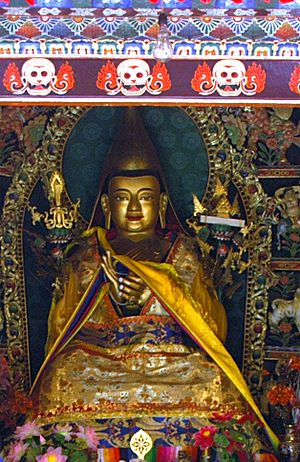
New tradition
Sam van Schaik says that Tsongkhapa "wanted to create something new" and that the early Gandenpas defined themselves by responding to accusations from the established schools:
Though the Sakya had their own teachings on these subjects, Tsongkhapa was coming to realize that he wanted to create something new, not necessarily a school, but at least a new formulation of the Buddhist Path.
Monasticism and lineage
Tsongkhapa emphasised a strong monastic Sangha. With the founding of the Ganden monastery in 1409, he laid down the basis for what was later named the Gelug ("virtuous ones") order. At the time of the foundation of the Ganden monastery, his followers became known as "Gandenbas." Tsongkhapa himself never announced the establishment of a new monastic order.
After Tsongkhapa had founded Ganden Monastery in 1409, it became his main seat. He had many students, among whom Gyaltsab Je (1364–1431), Khedrup Gelek Pelzang, 1st Panchen Lama (1385–1438), Togden Jampal Gyatso, Jamyang Choje, Jamchenpa Sherap Senge, and the 1st Dalai Lama (1391–1474), were the most outstanding. After Tsongkhapa's passing his teachings were held and kept by Gyaltsab Dharma Rinchen and Khedrub Gelek Pälsang. From then on, his lineage has been held by the Ganden Tripas, the throne-holders of Ganden Monastery, among whom the present one is Thubten Nyima Lungtok Tenzin Norbu, the 102nd Ganden Tripa.
After the founding of Ganden Monastery by Tsongkhapa, Drepung Monastery was founded by Jamyang Choje, Sera Monastery was founded by Chöje Shakya Yeshe and the 1st Dalai Lama founded Tashilhunpo Monastery. Many Gelug monasteries were built throughout Tibet but also in China and Mongolia. He spent some time as a hermit in Pabonka Hermitage, which was built during Songsten Gampo times, approximately 8 kilometres north west of Lhasa. Today, it is also part of Sera.
Among the many lineage holders of the Gelugpas there are the successive incarnations of the Panchen Lama as well as the Chagkya Dorje Chang, Ngachen Könchok Gyaltsen, Kyishö Tulku Tenzin Thrinly, Jamyang Shepa, Phurchok Jampa Rinpoche, Jamyang Dewe Dorje, Takphu Rinpoche, Khachen Yeshe Gyaltsen, Trijang Rinpoche, Domo Geshe Rinpoche, and many others.
Prayer Festival
The annual Tibetan prayer festival Monlam Prayer Festival was established by Tsongkhapa. There he offered service to ten thousand monks. The establishment of the Great Prayer Festival is seen as one of his Four Great Deeds. It celebrates the miraculous deeds of Gautama Buddha.
Western understanding of Madhyamaka
According to Karl Brunnholzl, Tsongkhapa's Madhyamaka has become widely influential in the western understanding of Madhyamaka:
First, with a few exceptions, the majority of books or articles on Madhyamaka by Western - particularly North American - scholars is based on the explanations of the Gelugpa school of Tibetan Buddhism. Deliberately or not, many of these Western presentations give the impression that the Gelugpa system is more or less equivalent to Tibetan Buddhism as such and that this school's way of presenting Madhyamaka is the standard or even the only way to explain this system, which has led to the still widely prevailing assumption that this is actually the case. From the perspective of Indian and Tibetan Buddhism in general, nothing could be more wrong. In fact, the peculiar Gelugpa version of Madhaymaka is a minority position in Indo-Tibetan Buddhism, since its uncommon features are neither found in any Indian text nor accepted by any of the other Tibetan schools.
Works
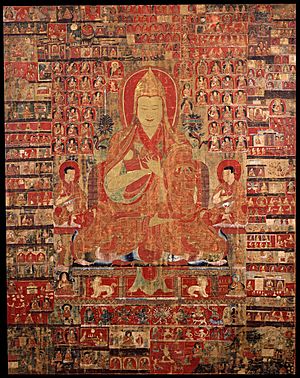
Tsongkhapa promoted the study of logic, encouraged formal debates as part of Dharma studies, and instructed disciples in the Guhyasamāja, Kalacakra, and Hevajra Tantras. Tsongkhapa's writings comprise eighteen volumes, with the largest amount being on Guhyasamāja tantra. These 18 volumes contain hundreds of titles relating to all aspects of Buddhist teachings and clarify some of the most difficult topics of Sutrayana and Vajrayana teachings. Tsongkhapa's main treatises and commentaries on Madhyamaka are based on the tradition descended from Nagarjuna as elucidated by Buddhapālita and Candrakīrti.
Major works
Major works among them are:
- The Great Treatise on the Stages of the Path to Enlightenment (lam rim chen mo),
- The Great Exposition of Secret Mantra (sngags rim chen mo),
- Essence of True Eloquence (drang nges legs bshad snying po; full title: gsung rab kyi drang ba dang nges pai don rnam par phye ba gsal bar byed pa legs par bshad pai snying po),
- Ocean of Reasoning: A Great Commentary on Nagarjuna's Mulamadhyamakakarika (dbu ma rtsa ba'i tshig le'ur byas pa shes rab ces bya ba'i rnam bshad rigs pa'i rgya mtsho),
- Brilliant Illumination of the Lamp of the Five Stages / A Lamp to Illuminate the Five Stages (gsang 'dus rim lnga gsal sgron),
- Golden Garland of Eloquence (gser phreng) and
- The Praise of Relativity (rten 'brel bstod pa).
English translations
- Biography
- Life and Teachings of Tsongkhapa, Library of Tibetan Works and Archives, 2006, ISBN: 978-81-86470-44-2
- Lam Rim = Great Treatise
- The Great Treatise On The Stages Of The Path To Enlightenment, Vol. 1, Snow Lion, ISBN: 1-55939-152-9
- The Great Treatise On The Stages Of The Path To Enlightenment, Vol. 2, Snow Lion, ISBN: 1-55939-168-5
- The Great Treatise On The Stages Of The Path To Enlightenment, Vol. 3, Snow Lion, ISBN: 1-55939-166-9
- Dependent-Arising and Emptiness: A Tibetan Buddhist Interpretation of Mādhyamika Philosophy, trans. Elizabeth Napper, Wisdom Publications, ISBN: 0-86171-364-8: this volume "considers the special insight section of" the Lam Rim (p. 8).
- Lam Rim - Medium Treatise
- The Medium Treatise On The Stages Of The Path To Enlightenment - Calm Abiding Section translated in "Balancing The Mind: A Tibetan Buddhist Approach To Refining Attention", Shambhala Publications, 2005, ISBN: 978-1-55939-230-3
- The Medium Treatise On The Stages Of The Path To Enlightenment - Insight Section translated in "Life and Teachings of Tsongkhapa", Library of Tibetan Works and Archives, 2006, ISBN: 978-81-86470-44-2
- The Medium Treatise on the Stages of the Path to Enlightenment (Calm Abiding Section) translated in B. Alan Wallace, Dissertation, 1995, (Wylie: byang chub lam gyi rim pa chung ba)
- Lam Rim - Small Treatise
- Golden Garland of Eloquence
- Golden Garland of Eloquence - Volume 1 of 4: First Abhisamaya, Jain Pub Co, 2008, ISBN: 0-89581-865-5
- Golden Garland of Eloquence - Volume 2 of 4: Second and Third Abhisamayas, Jain Pub Co, 2008, ISBN: 0-89581-866-3
- Golden Garland of Eloquence - Volume 3 of 4: Fourth Abhisamaya, Jain Pub Co, 2010, ISBN: 0-89581-867-1
- Golden Garland of Eloquence - Volume 4 of 4: Fourth Abhisamaya, Jain Pub Co, 2013, ISBN: 978-0-89581-868-3
- Madhyamaka
- Ocean of Reasoning: A Great Commentary on Nagarjuna's Mulamadhyamakakarika, Oxford University Press, ISBN: 0-19-514733-2
- Essence of True Eloquence, translated in The Central Philosophy of Tibet, Princeton University Press, ISBN: 0-691-02067-1
- Guided Tour Through the Seven Books of Dharmakirti, translated in A Millennium of Buddhist Logic, Motilal Barnasidass, 1999, ISBN: 81-208-1646-3
- Tantra
- The Fulfillment of All Hopes: Guru Devotion in Tibetan Buddhism, Wisdom Publications, ISBN: 0-86171-153-X
- Tantric Ethics: An Explanation of the Precepts for Buddhist Vajrayana Practice, Wisdom Publications, ISBN: 0-86171-290-0
- The Great Exposition of Secret Mantra - Chapter 1 of 13, translated in Tantra in Tibet, Shambhala Publications, 1987, ISBN: 978-0-937938-49-2
- The Great Exposition of Secret Mantra - Chapter 2 & 3 of 13, translated in Deity Yoga, Shambhala Publications, 1987, ISBN: 978-0-937938-50-8
- The Great Exposition of Secret Mantra - Chapter 4 of 13, translated in Yoga Tantra, Shambhala Publications, 2012, ISBN: 978-1-55939-898-5
- The Great Exposition of Secret Mantra - Chapter 11 & 12 of 13, translated in Great Treatise on the Stages of Mantra: Chapters XI–XII (The Creation Stage), Columbia University Press, 2013, ISBN: 978-1-935011-01-9
- The Six Yogas of Naropa: Tsongkhapa's Commentary, Snow Lion Publications, ISBN: 1-55939-234-7
- Lamp of the Five Stages
- Brilliant Illumination of the Lamp of the Five Stages, Columbia University Press, 2011, ISBN: 978-1-935011-00-2
- A Lamp to Illuminate the Five Stages, Library of Tibetan Classics, 2013, ISBN: 0-86171-454-7
- Yogacara
- Ocean of Eloquence: Tsong Kha Pa's Commentary on the Yogacara Doctrine of Mind, State University of New York Press, ISBN: 0-7914-1479-5
- Other
- The Splendor of an Autumn Moon: The Devotional Verse of Tsongkhapa Wisdom Publications, ISBN: 978-0-86171-192-5
- Three Principal Aspects of the Path, Tharpa Publications
- Stairway to Nirvāṇa: A Study of the Twenty Saṃghas based on the works of Tsong-kha-pa, James B. Apple, State University of New York Press, 2008, ISBN: 978-0-7914-7376-4
Images for kids
See also
 In Spanish: Je Tsongkhapa para niños
In Spanish: Je Tsongkhapa para niños


